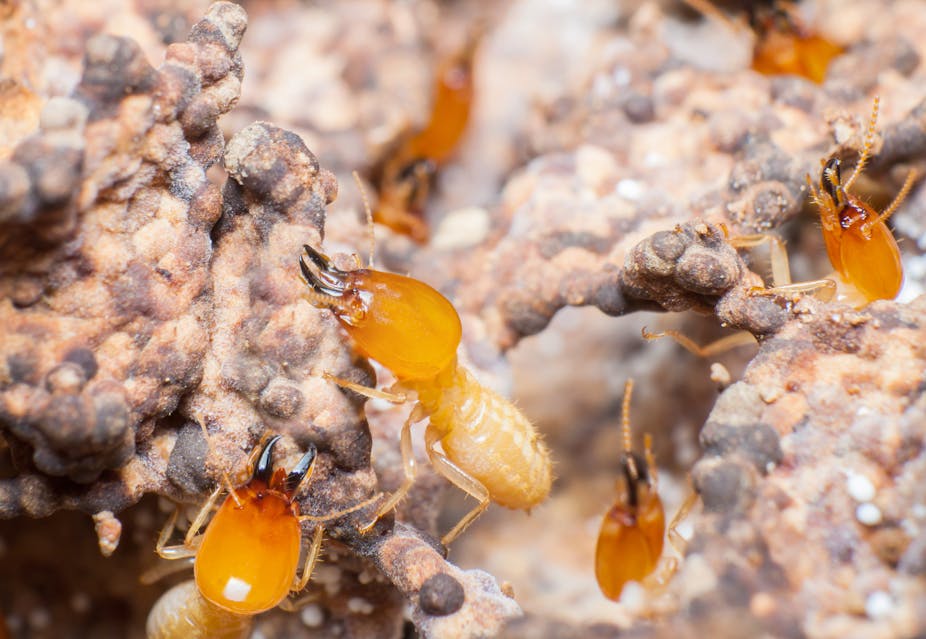Animal protein, in the form of meat and fish, is becoming more expensive all over the world. It’s getting out of reach for more people, particularly low income earners. Yet it can be a good source of nutrition, of instance, meat from animals is a very rich source of protein when cooked.
Insects have been an important part of human and animal diets over a long period of time, particularly in Africa, Asia and Latin America. Apart from the rich nutritional composition (high protein and fat content) they have, they are also cheap and accessible.
Termites (Macrotermes bellicosus) are one insect species that are widely consumed in African countries, being easy to collect. Termites can be spiced, roasted and eaten as a snack. They are a well known food in Nigeria’s south-west region, where they are called “esunsun”.
Other insects eaten in Nigeria include adult crickets (Brachytrypes species), and adult short-horned grasshoppers (Cytacanthacris naeruginosus unicolour).
Insects like termites are a rich and affordable source of protein and fat. But they don’t appeal to everyone as food. My study explored how to introduce them into diets in a palatable way. I tried making them into powder and mixing it with a common food product, in this case a vegetable soup powder. I tested different combinations of ingredients and came up with a product that was both nutritious and acceptable to consumers.
Ingredients
Diets are changing as populations urbanise, with consequences for health. Instant foods are popular but tend to be high in sugar, fat and salt. Dried soup powders, on the other hand, are convenient and can be a nutrient-packed option. One promising ingredient is a vegetable that’s already used in soup in Nigeria and is often processed into powder to preserve it: Clerodendrum volubile.
The plant is known as “Marugbo” or “Eweta” among the Ikale, Ilaje and Apoi people in Ondo State, South-West Nigeria and “Obnettete” among the Itsekiri and Urhobo in Niger-Delta. Because the plant has a lot of biologically active compounds and chemical constituents, the leaves when cooked as soup have been reported to stimulate lost appetite and replenish vitality in mothers of newborn babies. The dark soup obtained when the leaves are ground and cooked is popularly referred to as “Eweta” by the Ikales.
For my test, I obtained fresh Clerodendrum volubile leaves and some spices (turmeric, pepper, onion powder and ginger) from Iya-laje market in Ondo town. The termites (Macrotermes bellicosus) were freshly harvested during the early raining season (March/April) on farms and residential properties.
I washed and dried the vegetable leaves before grinding them into powder. I also washed the termites in saltwater, dried them, removed the wings and ground the bodies into fine powder. I mixed the termite and vegetable powders together in varying proportions, not exceeding 25g of termite powder per 100g of soup powder.
I checked the nutrient composition of the various powder mixes and, after cooking soup by adding water and spices, I served it to consumers who were familiar with both “esunsun” and “marugbo”. The tasters were asked to compare the soup’s colour, taste, mouthfeel, aroma and overall acceptability with the same soup made from 100% “marugbo”. Being familiar with the ingredients, the tasters were not biased against the soup from the start.
Nutrition and taste
Enrichment with termite powder resulted in a more nutritious vegetable soup. There was an increase in mineral content (from 6.27% in marugbo only to 7.72% in marugbo with termite), fat content (from 6.08% in marugbo only to 16.84% in marugbo with termite) and protein content (from 15.03% in marugbo only to 29.94% in marugbo with termite). This was expected as insects are rich in protein and fat. The more termite powder was included, the less vegetable content and fibre there was.
The tasters had no idea of the mix-proportion but they knew they were tasting a vegetable-insect mixture.
When judging the colour of the soup, consumers preferred mixes that had relatively more insects. For mouthfeel, they preferred the least quantity of insect powder. This wasn’t surprising, because they were not familiar with the use of termite powder in soups. In terms of overall acceptability, the soup with the lowest proportion of insects (10%) got the highest score. The tasters found all the termite soup samples to be much the same as vegetable-only soup.
Nutritional and economic benefits
This research has revealed that staple diets can be improved by the addition of insect powders rather than serving recognisable forms of insects, which some people find disgusting.
Increased awareness, exploration and acceptance of insects as alternative protein sources could make protein-rich diets available to more citizens. It could also yield economic benefits by developing a market for insects. There are many edible insects that are still under-explored for this purpose.

